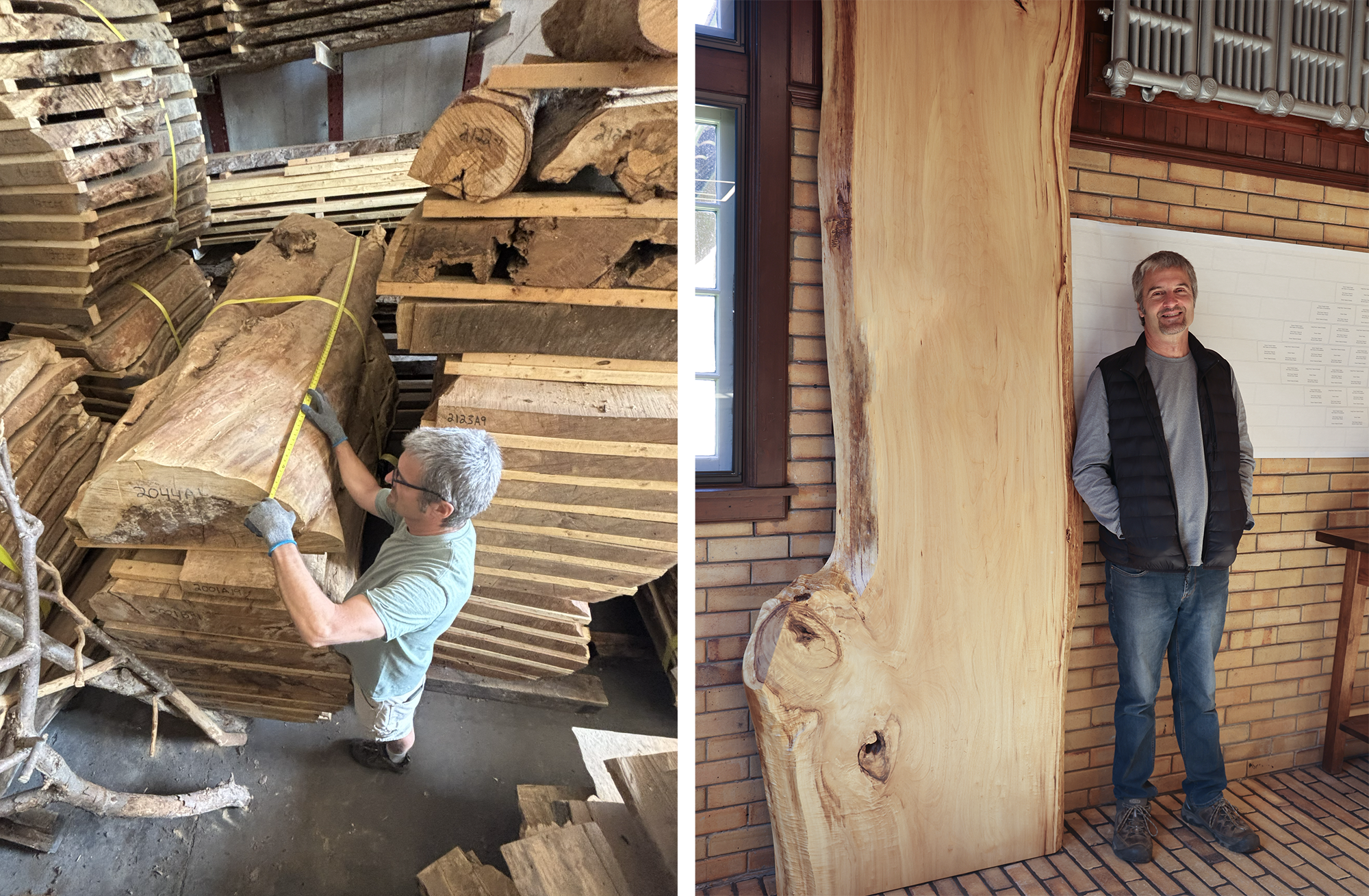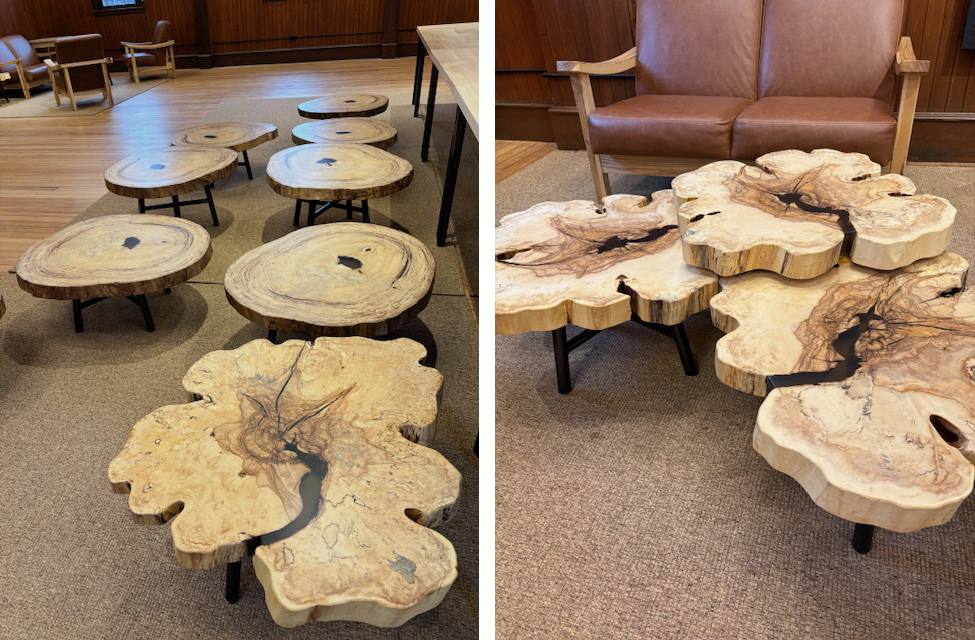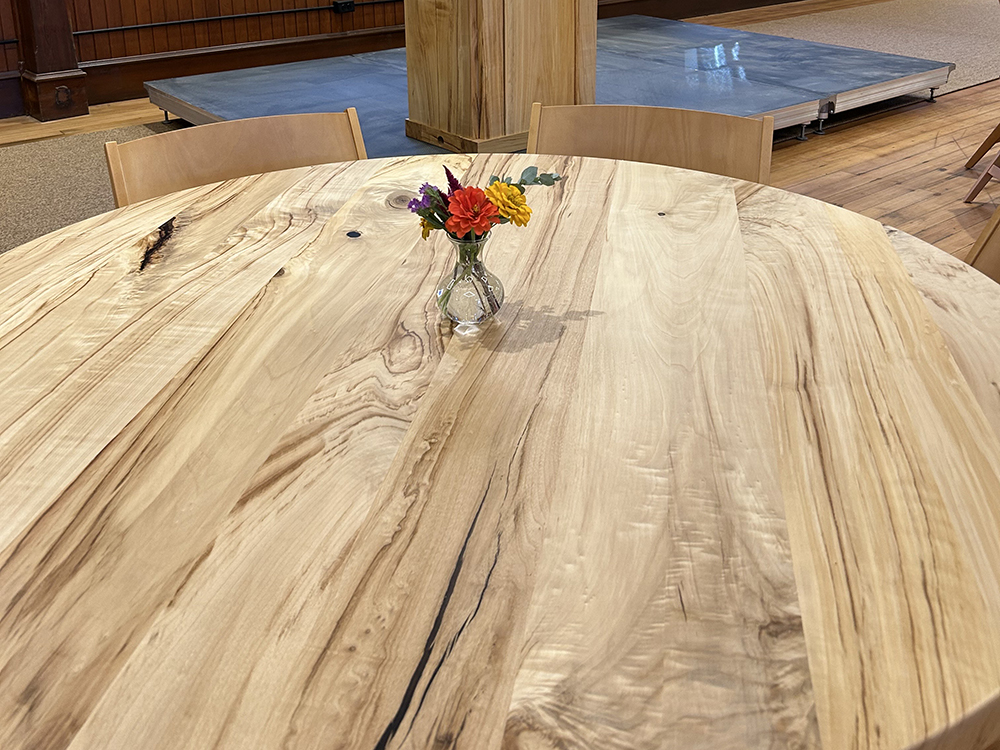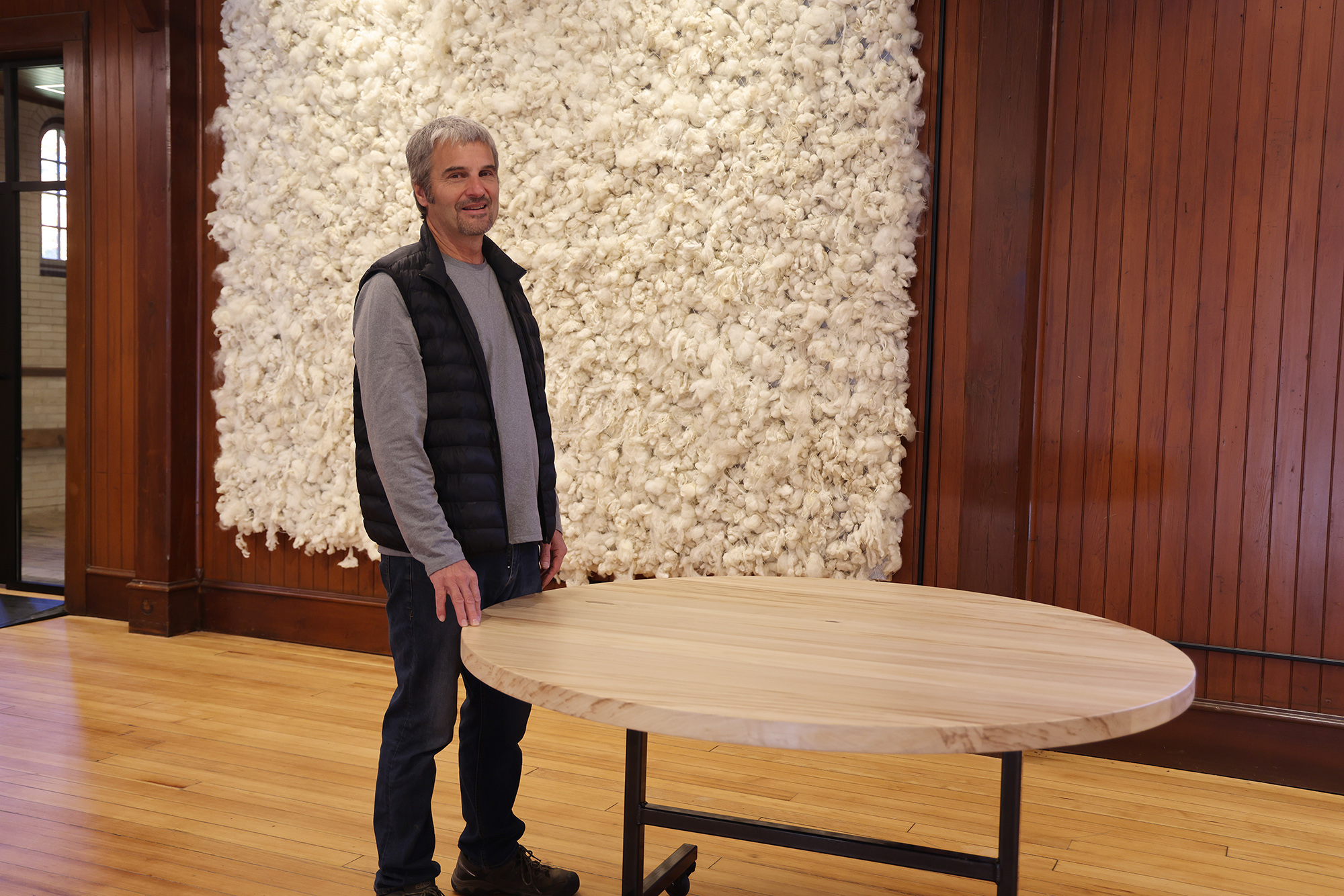A beautiful way to honor Marshall. We miss him.
Coach Barn Stories: From Trees to Tables
All of the tables in the new Coach Barn are made from wood harvested at Shelburne Farms. Most of that wood is poplar. John Monks of Vermont Tree Goods, the man behind the tables, explains why that’s the case, and what it means. Note: The interview has been edited for length and clarity.
How did you become involved in making the tables for the Coach Barn?
Back in 2018, I learned that Shelburne Farms was taking down big trees along Poplar Drive because they were starting to die, and were a hazard. But the Farm couldn’t find anybody to mill them, so they were going to be left to rot in the woods. I called and met with Marshall Webb to look at the trees. “We could mill them,” I said. In his mind and in my mind, to cut them and let them rot was wrong.
There were about 20 massive trees. We trucked them over to my shop, and slowly milled them into big slabs with natural edges. We air-dried the slabs for a couple of years, then kiln-dried them, then stacked and stored them.

Marshall had commissioned a few Farm tables before he passed, but after a few years, we started wondering, “What are we going to do with all this?” Then early in 2025, Shelburne Farms said, “We have this project at the Coach Barn, and we need lots of tables.” I said, “Okay, we've got lots of your wood!”
This summer we brought the wood slabs to Vermont Farm Table in Bristol, and as a production shop, they built and assembled all the tables.
How were you able to mill such big trees?
I had built this huge sawmill that's effectively a huge electric chainsaw. It's very unconventional. Most commercial sawmills don't want trees over about 24 inches in diameter, and a lot of these poplars were four feet or more wide–way beyond what any local commercial sawmills can handle.

How did you get involved in milling such big trees?
I was a house builder for many years, and started making some furniture for family and friends. But in 2010 we had a fire and lost all our belongings. (It was horrible, but thankfully nobody got hurt.) I set out to replace some of the furniture that I had built, and I wanted to make a large live-edge dining table. I couldn't really find the wood that I wanted, so I went to a couple of tree service companies and asked them what they did with the big trees they cut. One guy took me behind their shop and pointed at this huge pile of big logs and said, “We'll just burn it all this winter to make it go away.” Right then I knew what my mission was, because, to me, wasting all that wood was so wrong. That day really was sort of a life changing moment for me.

Why was using the wood from Poplar Drive important to you?
Well, for a number of reasons. One is environmental. Wood is approximately 50% carbon by weight, and a lot of people don't realize that if you let a tree rot, over 90% of its carbon will become carbon dioxide. There's this misconception that all the carbon just gets reabsorbed into the dirt and that's not the case. I have no idea what all those trees weighed--many, many tons—but they represented many, many tons of carbon dioxide.
The other main reason for me is aesthetics. Even though cottonwood is not considered high value in the lumber world, it's really quite beautiful stuff, as you can see by the tables. To throw out such beauty is like throwing out masterpieces.
And then there’s a spiritual side to it all. I read somewhere that we share half our DNA with trees. So in a way, we're related to them. We're descended from whoever they are descended from. We're all Earthlings.

How does this project fit into your overall approach to harvesting trees?
The traditional forestry model is based on what they call a tree’s “financial maturity”: once a tree is big enough to make a profit on it, you go in the woods and cut it. But I strongly believe that phrase should be replaced with “carbon maturity.”
Most trees die slowly. They may still be alive, but they're clearly at that end point. We've all seen it–like a big old maple tree in your yard losing one limb and then another. I call that point their peak carbon maturity. To me, if you're going to harvest a tree, that's the time to do it.
It turns out that many trees in our communities, whether they’re along a roadside or in people’s yards, are peak carbon trees. And if you look at their board footage, I believe that it's greater than the amount of wood we're taking out of the forests. We're basically wasting the vast majority of these “carbon mature” trees, and at the same time, cutting down relatively young trees in the forest.
I see us as finding homes for unwanted trees. The more homes we find, the more trees we get to recycle. It's really a very simple concept. That’s the motivation for me.
How do you hope people will experience or respond to these tables?
I don't think there's any one message. Hopefully, people will think, “Wow, these are beautiful. And isn't it wonderful that when those trees had to come down they were preserved, and we can continue to see their beauty, especially their interior beauty.”
When I started this business, I just wanted to make beautiful tables. As time has gone on, my motivation has shifted. Now it's much more about the environment and what we do with trees, especially trees coming out of our communities. I'm hoping very much that the carbon impact of recycling these trees is stressed. We shouldn't be viewing them as just part of the waste stream.

How does it feel to have these tables here as part of the Coach Barn?
For the wood to return to the Farm and be here for generations to come is the best possible scenario. I'm honored that I played a role in it.
But in many ways, I see this really as Marshall's gift. When there weren’t the resources to get the trees milled, he made it happen. We were kindred spirits when it came to the trees. For me more than anything, it's about Marshall.

Comments
AWESOME!! THANK YOU FOR SHARING THIS BEAUTIFUL STORY!!!
This is a beautiful and brilliant story. Expressed with Nature's eloquence. So much of Marshall's spirit is embedded in the tables. Those statuesque Poplars that once served as one Nature's ambassadors to the Farm Barn have returned.
Thank you, Mr. Monks. Your knowledge, skill, and passion for your craft is very special.
We were fortunate to be able to tour George Nakashima's studio in Bucks County with his daughter Mira who carries his legacy forward with her own designs. Venerating the legacy of magnificent trees the Nakashima Studio created unique pieces, like the Altars for Peace. Nakashima used slabs of enormous weight and size which fit the the great idea he envisioned for the world.
How wonderful to hear of the outcome for that allée along the walkway. Great trees deserve great ideas!
Thank you for sharing this insightful story!
